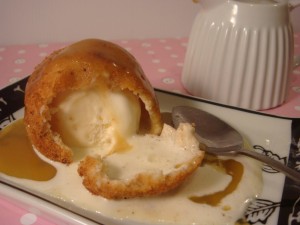Fried ice cream sounds gross. So does the lengthy time for an investigation, but that’s probably related to the Australian legal process, which doesn’t really seem to serve consumers.
 The Daily Telegraph reports a suspected outbreak of food poisoning at a Chinese restaurant at Wenty Leagues, New South Wales, west of Sydney, is being investigated by the NSW Food Authority.
The Daily Telegraph reports a suspected outbreak of food poisoning at a Chinese restaurant at Wenty Leagues, New South Wales, west of Sydney, is being investigated by the NSW Food Authority.
Up to 35 patrons – including 10 children – were believed to be struck ill after an evening out in September at the Jasmine Restaurant.
Three of the guests ended up in hospital, including a seven-year-old girl and four-year-old boy, and an adult who tested positive for Salmonella.
Wenty Leagues chief executive Mark Sheridan said the alleged incident on September 23 was being managed through the proper authorities.
“All inspections have been passed to the satisfaction of council and the food authority and the Jasmine Restaurant continues to trade,” Mr Sheridan said.
A group of 59 friends and family had eaten the banquet dinner on a Tuesday evening in honor of a 60th birthday.
They included mother of three Katrina Santos-Monses, who fell violently ill and two of her children, who were also affected.
“The food seemed nice,” Mrs Santos-Monses said. “But I did later suspect the fried ice-cream as it was melted inside and didn’t look like it normally does.”
The next day Mrs Santos-Monses and her children Cassandra, 7, and Sophie, 4, began suffering diarrhea, abdominal pain and high fever. She missed work and the children missed school and were ill the rest of the week.
A few days later, on the Saturday, during her six-month-old son’s christening ceremony, she collapsed. Both she and Cassandra were taken to Fairfield Hospital.
It was at the christening that guests began to realize more people were affected by the outbreak.
“It was like pieces of the puzzle were put together. There were cousins, uncles, so many people affected,” she said.
Mrs Santos-Monses is concerned at the length of time the investigation has taken.
“I’m mad that nobody has contacted me, to apologize or let me know what’s happened,” she said.
In early Jan. 2015, over 100 diners were sickened with Salmonella from fried ice cream at the at the Chin Chin Chinese restaurant in Brisbane.
A table of raw egg-related outbreaks in Australia is available at:
https://barfblog.com/wp-content/uploads/2015/12/raw-egg-related-outbreaks-australia-12-1-15.xlsx

